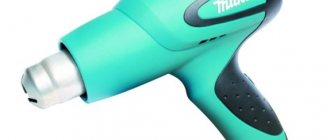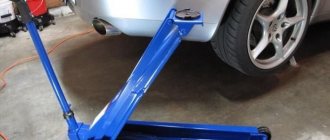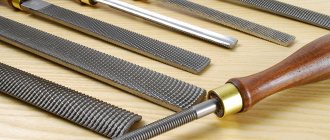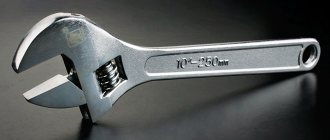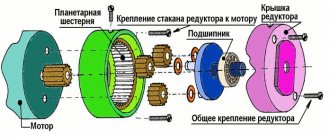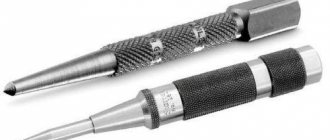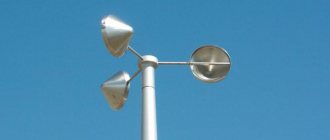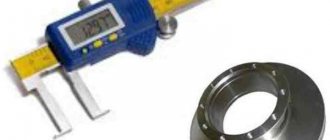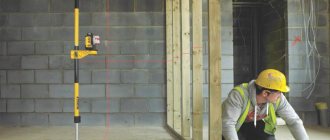What does a micrometer look like and what is it used for?
A small tool designed to accurately measure the dimensions of the smallest parts. It looks like a metal bracket with a screw mechanism and a graduation scale fixed at the top.
Using the device, miniature workpieces are measured, the dimensions of which cannot be determined by other methods. The device is in demand in the foundry and jewelry industries; it is used by turners and millers, model makers and laboratory assistants.
Important! The tool can only measure hard parts because soft materials change size when compressed.
Description and action
The device on the modern market is represented by many types and models, which do not differ significantly in operating principle and operating rules. The only exceptions are electronic and laser devices.
The name of the instrument indicates the dimensional value within which the device is able to determine the size of the part with reliable accuracy. One micron is a very small parameter; in practice, an accuracy of 50 microns is more often used - this is a value whose value can affect the result of assembly work or part settings.
Read also: Cone drill chuck
Methods of measuring with a micrometer - absolute and relative . In the first option, the device connector is attached directly to the surface of the part. Fastening clamps are adjusted in accordance with the geometry of the part being measured. Readings in microns are taken according to measuring scales.
The relative method is based on data taken when measuring objects that are in close proximity to the desired object of measurement. Subsequently, with their help, the required parameters of this object are established in an indirect mathematical way.
What is the operating principle of a micrometer based on?
The device has a fairly simple mechanism of action. Its usage looks like this:
- first check the accuracy of the device, then unscrew the screw so that the part fits between its tip and the heel;
- clamp the desired element using a ratchet until three characteristic clicks are heard;
- look at the readings on the digital, mechanical or dial cabinet of the device.
The device displays the distance remaining between the heel and the screw after clamping the part, and this interval is equal to its size. In this case, the full values are looked at on the scale on the stem of the instrument, and the fractions are determined by the circular sections on the drum. To get the final result, the numbers must be added.
How to use a smooth micrometer correctly?
Measurements with a smooth micrometer are carried out in accordance with the rules. The part being measured and the surfaces of the device must be wiped. Before starting measurements, the smooth running of the screw is checked and the instrument is set to “zero”. To do this, the measuring surfaces are aligned using a setting measure, after which the microscrew is locked. Next, the zero stroke of the circular scale on the drum is combined with the longitudinal stroke of the linear scale placed on the stem.
The part is placed between the heel and the end part of the microscrew, after which the drum is installed in the required position with a ratchet. The need to stop rotating the drum is indicated by three clicks made by the ratchet. Sizing is determined using all scales. First, data is read from the main and additional scales on the stem, shifted relative to each other by 0.5 mm. The whole millimeters on the lower scale are read first, just like when using a regular measuring stick. This is where the similarities in taking measurements end.
What types of micrometers are there?
Since the device is used in a variety of areas, there are quite a few varieties. In particular, micrometers are distinguished:
- smooth;
- lever;
- universal;
- leafy;
- wire;
- pipe;
- prismatic;
- groove;
- tooth-measuring.
There is also a classification of micrometers according to the method of taking measurements; there are mechanical instruments, laser, with a dial or digital scale.
Types of micrometers by area of application
The requirements are different in different areas; in some areas very precise instruments are needed, in other areas miniature or elongated instruments are needed. Therefore, it is customary to distinguish several types of micrometer, between which there are noticeable differences.
Smooth micrometer
This type is intended for external measurement of workpieces and parts. In fact, it is suitable for any work except internal measurements; the characteristics and design of a smooth micrometer do not allow the latter. The device consists of a bracket and a screw mechanism with a drum; models within the category differ only in range.
Smooth models are universal and most widespread
Sheet micrometer
Such devices are used to determine the dimensions of very thin workpieces with a wide surface, forged and metal strips, and sheet metal. A standard smooth micrometer may give erroneous readings due to a loose fit. The sheet-type tool is equipped with special round “plates” on the screw and on the heel.
Sheet metal plates increase the contact area with the workpiece
Micrometer for hot rolled metal
A separate type of device is used to measure the thickness of hot workpieces. Maintains a temperature range of 650 degrees; in production, it helps to track the moment when the rental needs to be stopped and the finished part of the required dimensions needs to be picked up.
The micrometer for hot rolled steel does not have a classic bracket, but has a long handle
Micrometer for deep measurement
Such models have a strongly elongated bracket, which allows you to throw the device over the workpiece and measure the thickness in a place far from the edge. Using the tool, the exact parameters of parts with an uneven perimeter and blind holes are determined.
Extended bracket allows you to reach any place with a micrometer for deep measurements
Pipe micrometer
Using a tool, the walls of metal pipes are measured. A special feature of the pipe type device is the trimmed bracket. At its end there is a heel, which is inserted into the pipe, after which the screw is tightened in the standard way.
Important! It is usually impossible to take internal measurements with a smooth micrometer. It only fits into very wide holes due to the classic staple and protruding heel.
A pipe gauge is used to measure the walls of pipes
Wire micrometer
A very compact variety without a pronounced bracket. The tool itself is more like a rod. It is used to determine the dimensions of wire and thin metal rods. The device has a small screw stroke range; it can be carried in a case along with screwdrivers and keys.
Wire micrometer is one of the smallest types
With small lips
Using such a tool, external recesses and grooves in the metal surface are measured. The working parts of the device easily fit into microscopic holes.
The screw and heel of a device with small jaws are very thin
Universal micrometer
This device is equipped with numerous removable tips for measuring a wide variety of parts and workpieces. It is convenient to use, but can give a large error, since if the tip is not tightened sufficiently, a gap occurs. This problem is especially common in budget devices.
A device with attachments can replace several highly specialized varieties
Groove micrometer
The device has no bracket at all. Most of all, a micrometer is similar to a wire micrometer. But unlike the latter, it is equipped with sponge plates for gripping protruding parts of workpieces.
Using a groove device, the thickness is measured in hard-to-reach parts of the part.
Gear micrometer
The device is used to measure hard-to-reach external places of parts and to determine the length of the common normal of grooves, grooves and gears. A design feature is the fixed jaw-plates; other similar types of devices have a slight backlash for them.
A gear tool is similar to a sheet tool, but has smaller plates
Prismatic micrometer
Instead of a heel, there is an angular bracket with attachments made of hard alloys, forming a supporting prism. A device of this type is used to determine the diameter of a multi-blade tool.
The prismatic micrometer can measure three-, five- and seven-blade instruments
Lever micrometer
The device is used for comparative serial measurement of parts. The device is an analogue of a lever bracket, but it is easier to use; it does not require a long time to adjust it to the nominal length gauges.
A lever micrometer has a movable heel moving along the axis, acting on the lever
Types of micrometers by indication method
Devices are also usually divided according to the type of indication. Some devices allow measurements to be taken in the shortest possible time and do not require additional calculations from the user.
Mechanical
The simplest and most budget devices are equipped with a vernier drum, with which dimensions are taken. The workpiece parameters must be determined using scales printed on the surface of the tool.
When using a mechanical micrometer, the user is forced to calculate the measurement results himself.
Switches
Such devices are equipped with an indicator with a circular scale and a pointer in a closed housing. Many lever and sheet tool models, especially Soviet-made ones, belong to the switch type.
Pointer devices are also called clock devices
Digital
One of the most convenient to use varieties is equipped with an electronic display. The measurement results are displayed on the screen; the user does not need to carry out any additional calculations.
Digital micrometers are used in production, where a series of measurements need to be taken in a short time.
Laser
The most modern and expensive type of device. The measurement results are calculated based on the difference in the deflection of the laser beam, and the instrument displays the finished data on the display. Most often, devices are used in laboratories where extreme accuracy is important.
There is no point in buying a laser micrometer for home - it is expensive, and its capabilities are not in demand
How does a micrometer work and what main parts does it consist of?
Among the main components of a micrometer are:
- a bracket with a heel protruding inward;
- a screw mechanism attached to the other end;
- drum and ratchet, with the help of which the screw rotates;
- a clamping element on the side that allows you to fix the mechanism in a certain position.
Depending on the design of the micrometer, its main part, the bracket, can be more or less pronounced. The screw and heel are often equipped with special attachments.
The classic micrometer design involves a bracket, drum and ratchet
What is the structure and principle of operation of a smooth micrometer
The operating principle of a smooth micrometer is the simplest. This type of tool is the most common in everyday life:
- All mechanisms of the device are located on the bracket; the role of a fixed stop is performed by a rigidly fixed heel.
- At the other end there is a cylindrical stem with a printed scale, the division value is usually 0.5 mm.
- A screw passes through the inside of the stem, one side extends towards the heel, and the other is rigidly connected to the drum.
- The drum also has a scale with a division value of about 0.01 mm, for counting hundredths and thousandths during measurements.
The drum and ratchet of a smooth type device are usually covered with anti-slip notches.
According to the purpose of a smooth micrometer, when using it, it is necessary to insert the workpiece between the screw and the heel and fix it tightly. The ratchet on the outer end of the drum is responsible for stopping the rotation of the screw after the part is securely fastened. It also prevents the mechanism of the device from being damaged by excessive force.
How does a lever micrometer work?
The design of a lever pointer device is very similar to a conventional one. However, there are also differences. The micrometer device diagram shows that the instrument consists of:
- brackets, in the body of which a lever-gear system for counting is mounted;
- round dial with graduation scale;
- drum and stem attached to a bracket;
- screw and heel, between which the part is clamped.
During measurements, movement from the rod is transmitted using a special lever to a gear mechanism. The latter engages with a small wheel, on the axis of which there is an arrow indicating the measurement results.
A lever micrometer is more reliable than a smooth one, but is more prone to breakage
To retract the measuring rod in the lever mechanism, a button is used that activates the locking device. There is no ratchet in this type of device. It is simply not needed, since a stable and safe measuring force is created without it.
Types of micrometers
Depending on the purpose and design, the following types of devices are distinguished:
- MK - the most famous smooth micrometers. Used to measure external dimensions.
- ML - leafy. Designed for measuring the thickness of sheets and tapes. Equipped with a dial.
- MT - pipe. Designed for measuring pipe wall thickness.
- MZ - tooth-measuring. Allows you to measure the general normals of cylindrical gears. This is an important type of quality control for tooth manufacturing.
- MG - micrometer heads. They are used to measure movement.
- MP - micrometers designed to measure wire thickness.
How to choose a micrometer
When choosing a measuring device, you must take into account your own needs and the parameters of the micrometer. There are several criteria that determine ease of use.
Type of micrometer
The devices can be designed for carrying out internal and external measurements, for dense and thin, easily deformable workpieces. Before buying a device, you need to understand for what purpose it will be used.
Measuring range
Different instruments can take measurements in a general range from 0 to 100 mm. Which device to choose depends on the size of the workpieces.
Measurement step
The finer the scale of divisions of the device, the more accurate the results obtained will be. You need to focus on the dimensions of the parts and your own needs.
Advice! The most precise devices are usually needed by jewelers working with microscopic workpieces.
Error
The error value is indicated in the technical data sheet of the device. The lower the indicator, the lower the likelihood of error when taking measurements.
Tool weight
The device should not weigh more than 2 kg, otherwise it will be inconvenient to use. When purchasing, you should also evaluate the comfort of gripping the device. It is desirable that the bracket be equipped with a relief insert.
Specifications.
2.1. The measuring surfaces of the micrometer are equipped with carbide tips. A micrometer head with a division value on the drum of 0.01 mm and a unified indicator reading device of a lever-gear type with a division value of 0.001 mm are used as a reading device.
2.3. The microscrew in the micrometer head is hardened, with a ground thread. Scale: stem and drum with matte chrome finish. The microscrew stroke of the lever micrometer is 25 mm.
2.4. The measuring force during the measurement process is 3-8 N. The measuring range of the indicator reading device is ±30 µm.
2.5. Technical characteristics of lever micrometers are given in Table 1.
Table 1 - Technical characteristics of MR type lever micrometers
| Model | Measuring range, mm | Readout resolution, mm | Measurement error, mm | Weight, kg | |
| by micrometer head | by indicator | ||||
| MR-25 | 0-25 | 0,01 | 0,001 | 0,001 | 0,9 |
| MP -50 | 25-50 | 0,01 | 0,001 | 0,001 | 1,2 |
Top 5 best micrometers of 2021
When choosing a reliable and convenient micrometer, it is useful to familiarize yourself with the rating of the most popular models. They are in demand due to their high accuracy, reliability and moderate cost.
Matrix 317255
An inexpensive device made in Germany and assembled in China, it is designed for measurements in the range of 0-25 mm. The error is only 2 microns, the device is optimal for repairmen, modelers and car mechanics. Made of high-quality enameled steel, equipped with thermal insulating linings on the bracket. The heel and tip of the screw are carbide and do not wear out even with frequent use of the device.
You can buy a Matrix micrometer from 840 rubles
Fit 19909
The purpose of a micrometer with an error of 0.01 mm is to use it in a home workshop or in production where laboratory accuracy is not required. Measures thickness within 0-25 mm, features reliable assembly and corrosion resistance. The drum and ratchet are covered with anti-slip grooves. The kit includes a calibration key and a plastic case.
Important! Among the disadvantages, the scales on the stem and drum are too pale; in order to distinguish the readings, you have to strain your eyes.
The average price of a Fit micrometer starts from 900 rubles
Shan MK-25 123738
A tool from the middle price category with a range of 0-25 mm has high accuracy, the error is only 2 microns. Equipped with carbide measuring surfaces with excellent alignment, the scale of the device is clear and clearly visible.
You can buy Shan MK-25 from 2500 rubles
CHEEZ MK-25 0.01
The Russian device of the first class of accuracy takes measurements of 0-25 mm, guaranteeing a low error. The ratchet and drum are covered with deep notches that prevent slipping of hands, and thermal insulating gaskets are provided on the bracket. The description of the micrometer indicates that the heel and screw mechanism are made of stainless steel, and the working surfaces are coated with carbide coating for a perfect fit.
You can buy a CHIZ micrometer from 2000 rubles
Micromar 40 EWRI 4157101
One of the top German-made devices belongs to the professional category. It has a range of 25-50 mm, the degree of accuracy is 0.001 mm. Made of high quality steel with anti-corrosion coating.
The device supports wide customization of measurement parameters and displays results, including in inches. The main feature of the device is the presence of a Wi-Fi module, thanks to which data can be transferred directly to a computer through a special application.
Micromar 40 EWRI is expensive, from 28,000 rubles
Verification
Verification is carried out in accordance with the methodological instructions MI 782−85.
Knowledge of the verification methodology is important not only for the specialist conducting it, but also for the worker who uses the measuring instrument and strives to be qualified.
It may seem that when using a micrometer at home, knowledge about verification operations is not needed, but this is not so. Deviation from the norm of individual controlled parameters is noticeable to the naked eye.
Among these parameters:
- deviation from flatness of measuring surfaces;
- deviation from parallelism of measuring surfaces;
- distortion of the flat measuring surface of the screw.
The appearance of such deviations should alert you and prompt you to make a decision about the need to repair the measuring device.
Now, having extensive information on taking measurements with a micrometer, on its design and methods for monitoring the quality of its readings, you can be sure that any questions about the micrometer, how to use it, including, will never be taken by surprise.
Content
How to use a micrometer
Micrometers measure the dimensions of parts with an accuracy of tenths and hundredths of a millimeter. The tool looks like a caliper. But the micrometer differs from it in its versatility and increased accuracy.
From the outside it seems that this is a very complex device. But this is only at first glance. Anyone can learn to use different types of micrometers. We'll talk about this in this article.
